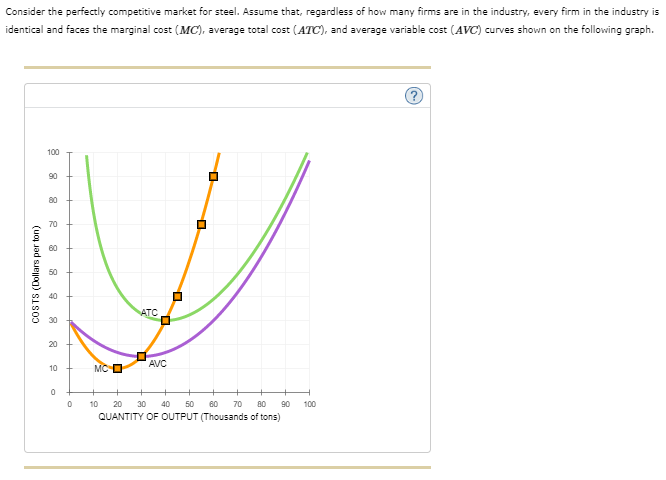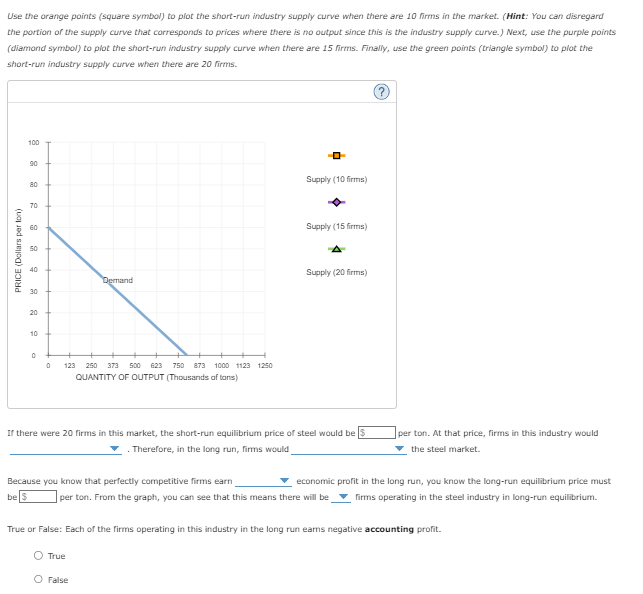Consider the perfectly competitive market for steel. Assume that, regardless of how many firms are in the industry, every firm in the industry is identical and faces the marginal cost (MCMC), average total cost (ATCATC), and average variable cost (AVCAVC) curves shown on the following graph. The following diagram shows the market demand for steel. Use the orange points (square symbol) to plot the short-run industry supply curve when there are 10 firms in the market. (Hint: You can disregard the portion of the supply curve that corresponds to prices where there is no output since this is the industry supply curve.) Next, use the purple points (diamond symbol) to plot the short-run industry supply curve when there are 15 firms. Finally, use the green points (triangle symbol) to plot the short-run industry supply curve when there are 20 firms. If there were 20 firms in this market, the short-run equilibrium price of steel would be per ton. At that price, firms in this industry would. Therefore, in the long run, firms would the steel market. Because you know that perfectly competitive firms earn economic profit in the long run, you know the long-run equilibrium price must be per ton. From the graph, you can see that this means there will be firms operating in the steel industry in long-run equilibrium.
Consider the perfectly competitive market for steel. Assume that, regardless of how many firms are in the industry, every firm in the industry is identical and faces the marginal cost (MCMC), average total cost (ATCATC), and average variable cost (AVCAVC) curves shown on the following graph. The following diagram shows the market demand for steel. Use the orange points (square symbol) to plot the short-run industry supply curve when there are 10 firms in the market. (Hint: You can disregard the portion of the supply curve that corresponds to prices where there is no output since this is the industry supply curve.) Next, use the purple points (diamond symbol) to plot the short-run industry supply curve when there are 15 firms. Finally, use the green points (triangle symbol) to plot the short-run industry supply curve when there are 20 firms. If there were 20 firms in this market, the short-run equilibrium price of steel would be per ton. At that price, firms in this industry would. Therefore, in the long run, firms would the steel market. Because you know that perfectly competitive firms earn economic profit in the long run, you know the long-run equilibrium price must be per ton. From the graph, you can see that this means there will be firms operating in the steel industry in long-run equilibrium.
Economics (MindTap Course List)
13th Edition
ISBN:9781337617383
Author:Roger A. Arnold
Publisher:Roger A. Arnold
Chapter21: Production And Costs
Section: Chapter Questions
Problem 16QP
Related questions
Question
Consider the perfectly competitive market for steel. Assume that, regardless of how many firms are in the industry, every firm in the industry is identical and faces the marginal cost (MCMC), average total cost (ATCATC), and average variable cost (AVCAVC) curves shown on the following graph.
The following diagram shows the market demand for steel.
Use the orange points (square symbol) to plot the short-run industry supply curve when there are 10 firms in the market. (Hint: You can disregard the portion of the supply curve that corresponds to prices where there is no output since this is the industry supply curve.) Next, use the purple points (diamond symbol) to plot the short-run industry supply curve when there are 15 firms. Finally, use the green points (triangle symbol) to plot the short-run industry supply curve when there are 20 firms.
If there were 20 firms in this market, the short-run equilibrium price of steel would be
per ton. At that price, firms in this industry would. Therefore, in the long run, firms would the steel market.
Because you know that perfectly competitive firms earn economic profit in the long run, you know the long-run equilibrium price must be
per ton. From the graph, you can see that this means there will be firms operating in the steel industry in long-run equilibrium.
True or False: Each of the firms operating in this industry in the long run earns negative accounting profit.
True
False

Transcribed Image Text:Consider the perfectly competitive market for steel. Assume that, regardless of how many firms are in the industry, every firm in the industry is
identical and faces the marginal cost (MC), average total cost (ATC), and average variable cost (AVC) curves shown on the following graph.
100
90
80
70
COSTS (Dollars per ton)
8
8
30
20
10
0
+
0
MC
ATC
AVC
D
D
D
10 20 30 40 50 60 70 80 90
QUANTITY OF OUTPUT (Thousands of tons)
100

Transcribed Image Text:Use the orange points (square symbol) to plot the short-run industry supply curve when there are 10 firms in the market. (Hint: You can disregard
the portion of the supply curve that corresponds to prices where there is no output since this is the industry supply curve.) Next, use the purple points
(diamond symbol) to plot the short-run industry supply curve when there are 15 firms. Finally, use the green points (triangle symbol) to plot the
short-run industry supply curve when there are 20 firms.
PRICE (Dollars per lon)
100
90
80
70
60
50
40
30
20
10
0
0
Demand
+
123 250 373 500 623 750 873 1000 1123 1250
QUANTITY OF OUTPUT (Thousands of tons)
Because you know that perfectly competitive firms earn
be 5
0
Supply (10 firms)
O True
O False
a>
Supply (15 firms)
If there were 20 firms in this market, the short-run equilibrium price of steel would be
. Therefore, in the long run, firms would
4
Supply (20 firms)
per ton. From the graph, you can see that this means there will be
per ton. At that price, firms in this industry would
the steel market.
economic profit in the long run, you know the long-run equilibrium price must
firms operating in the steel industry in long-run equilibrium.
True or False: Each of the firms operating in this industry in the long run earns negative accounting profit.
Expert Solution
This question has been solved!
Explore an expertly crafted, step-by-step solution for a thorough understanding of key concepts.
This is a popular solution!
Trending now
This is a popular solution!
Step by step
Solved in 5 steps with 1 images

Knowledge Booster
Learn more about
Need a deep-dive on the concept behind this application? Look no further. Learn more about this topic, economics and related others by exploring similar questions and additional content below.Recommended textbooks for you

Economics (MindTap Course List)
Economics
ISBN:
9781337617383
Author:
Roger A. Arnold
Publisher:
Cengage Learning


Economics: Private and Public Choice (MindTap Cou…
Economics
ISBN:
9781305506725
Author:
James D. Gwartney, Richard L. Stroup, Russell S. Sobel, David A. Macpherson
Publisher:
Cengage Learning

Economics (MindTap Course List)
Economics
ISBN:
9781337617383
Author:
Roger A. Arnold
Publisher:
Cengage Learning


Economics: Private and Public Choice (MindTap Cou…
Economics
ISBN:
9781305506725
Author:
James D. Gwartney, Richard L. Stroup, Russell S. Sobel, David A. Macpherson
Publisher:
Cengage Learning

Microeconomics: Private and Public Choice (MindTa…
Economics
ISBN:
9781305506893
Author:
James D. Gwartney, Richard L. Stroup, Russell S. Sobel, David A. Macpherson
Publisher:
Cengage Learning


Managerial Economics: A Problem Solving Approach
Economics
ISBN:
9781337106665
Author:
Luke M. Froeb, Brian T. McCann, Michael R. Ward, Mike Shor
Publisher:
Cengage Learning